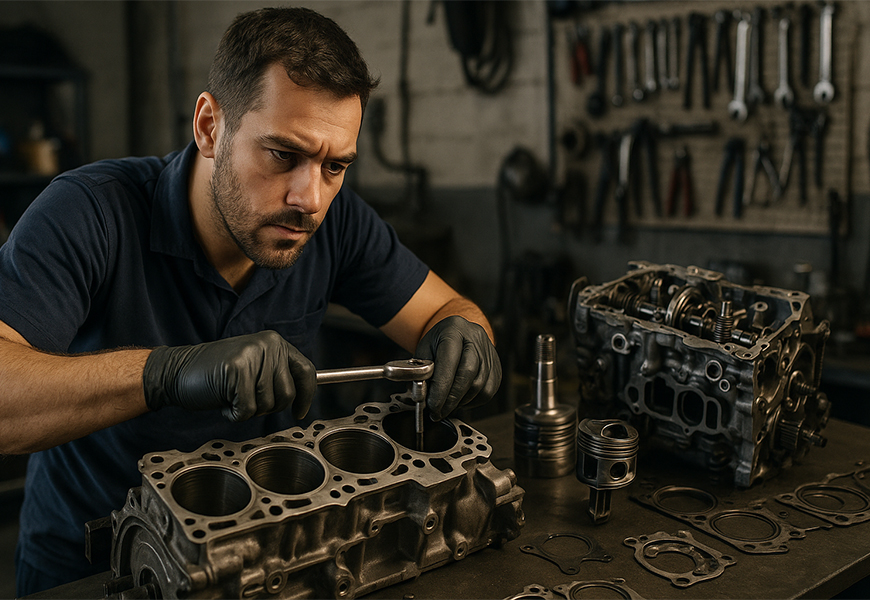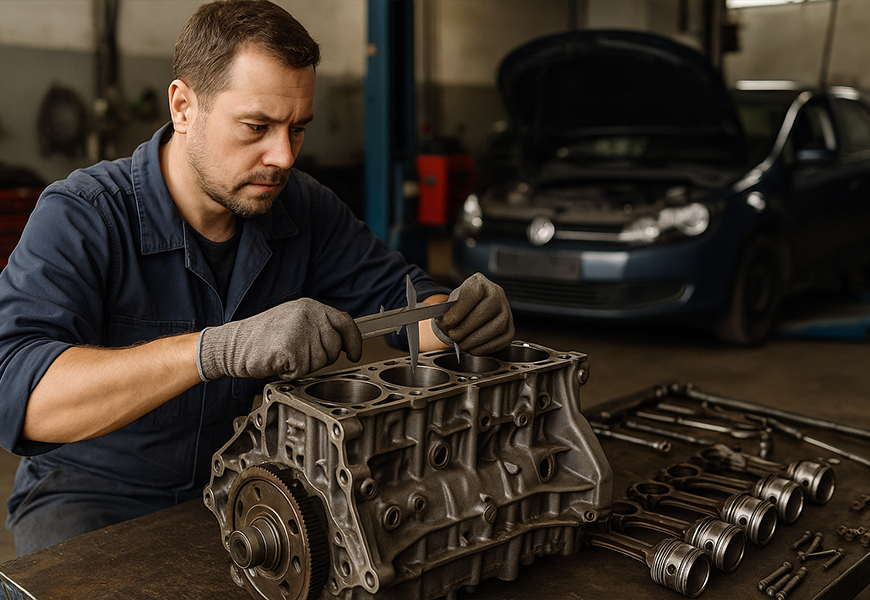What’s Included in an Engine Overhaul: Stages, Signs, and Tips

An engine overhaul is not just a “major repair” — it’s a full restoration of the engine’s performance and lifespan to a condition as close as possible to factory standards. Such a repair restores engine power, smooth operation, and fuel efficiency.
It is performed when regular maintenance or partial repairs no longer help, and the engine’s resource is almost completely exhausted.
When Does an Engine Need an Overhaul?
You can determine that it’s time for an overhaul by several key signs:
- Reduced compression in cylinders — the engine loses power and feels sluggish.
- Increased oil consumption — noticeable bluish smoke from the exhaust.
- Unusual noises or knocking during engine operation.
- Difficult starting or unstable idle speed.
- Overheating even with a functional cooling system.
- High fuel consumption without clear reasons.
- Metal shavings in the oil — a sign of internal wear.
- Mileage over 250,000–300,000 km, especially without consistent maintenance.
An overhaul may also be required after hydrolock, overheating, oil starvation, or the use of poor-quality fuel.

Engine Overhaul Stages
- Diagnostics and Disassembly
First, a complete computer and mechanical diagnostic check is performed — compression, oil pressure, smoke levels, and error codes are analyzed.
Then the engine is removed from the car — the gearbox, fuel, cooling, and electrical systems are disconnected.
- Disassembly and Inspection
The engine is completely dismantled: pistons, rods, crankshaft, valves, and cylinder block.
Each component is checked for wear, play, cracks, deformation, geometry, and seating condition. A defect report is prepared.
- Cleaning and Washing Components
All parts are cleaned using high-pressure washers or ultrasonic baths to remove carbon deposits, oil residue, and oxidation.
- Machining
After diagnostics, machining processes are performed such as grinding, honing, boring, or crankshaft polishing.
This restores correct geometry, clearances, and ensures proper piston group function.
- Replacement or Restoration of Parts
At this stage, the following components are replaced:
- piston rings and bearings;
- gaskets, seals, and O-rings;
- valves, valve guides, and stem seals;
- and sometimes pistons, rods, the cylinder head, or the engine block.
If a part can be repaired, techniques such as welding, spraying, chroming, or polishing are used.
- Engine Assembly
After preparing all components, the engine is reassembled according to technical specifications.
Torque wrenches are used to ensure proper tightening. All oil channels are cleaned for smooth lubrication flow.
- Adjustment and Calibration
Valve clearances, timing phases, ignition angle, and shaft synchronization are adjusted. The fuel system, turbocharger, VVT system, compression, and balance are checked.
- Installation, Start-Up, and Break-In
The rebuilt engine is reinstalled in the car. The first start-up and leak tests are performed, followed by a break-in period at moderate RPM (up to 1000 km). This allows the new components to settle and the system to stabilize.
Results of a Complete Engine Overhaul
After a high-quality overhaul, you get:
- Restored power and torque;
- Reduced fuel and oil consumption;
- Lower noise and vibration levels;
- Extended service life (up to 200,000–300,000 km);
- Reliable and stable performance with proper maintenance.
Why You Should Trust Professionals with an Engine Overhaul
An engine overhaul is a precise engineering process where even the smallest error can lead to another costly repair.
Entrust your engine to certified auto services that have:
- modern diagnostic equipment;
- experienced engine specialists;
- access to original spare parts;
- warranty for the performed work.
Conclusion
A complete engine overhaul is a full renewal of your car’s heart. It brings back performance, reliability, and driving confidence. Although it’s a complex and expensive procedure, a properly done rebuild is an investment in your vehicle’s long-term dependability.
